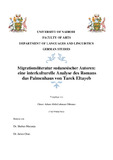| dc.contributor.author | Omer, Adam Abdulrahman Othman | |
| dc.date.accessioned | 2016-11-16T12:06:16Z | |
| dc.date.available | 2016-11-16T12:06:16Z | |
| dc.date.issued | 2016-11 | |
| dc.identifier.uri | http://hdl.handle.net/11295/97458 | |
| dc.description.abstract | The literature of migrants has increasingly importance due to the big demographic change that the world experiences in the aftermath of the globalization in the early 1990s. Conferences are being held, books publishing in order to discuss the role of this (new literature) by focusing on intercultural misunderstandings that arise from the encounter two or more different cultures. Cultural dialogue promises to provide a step on towards the solution by comparing the cultures and searching for similarities and differences in an effort to figure out a common basis for an effective intercultural dialogue. The literature of migrants illustrates the encounter with other cultures and is therefore able to problematize the illusion of uniformity.
Although migration literature in general has attracted worldwide attention by scholars of various academic disciplines, so far, the literature of African migrants in the German-speaking countries however has not been addressed adequately. This study aimed to implement an intercultural dimension of the novel das Palmenhaus by the Sudanese writer, living in Austria, Tarek Eltayeb. It focused on cultural-anthropological aspects and elaborated the similarities and differences between both cultures, between Sudan and Austria at both the thematic and character analysis levels. A very important aspect of the study was to explore the impact of migration on the cultural identity by discussing the following questions: what an African migrant lose from his original culture, what he wins in his new culture and what are the changes in his cultural identity?
The analysis was based on the intercultural and the postcolonial theories. Approaches like Introduction to intercultural literature of Michael Hoffmann and modes of the other by Ortfried Schäffter formed theoretical framework of the intercultural analysis and comparison of the two cultures involved. Homi K. Bhabha´s concept of Hybridity and Third Space (Bhabha 1994) on the other hand, was used to investigate changes in the cultural identity of the protagonist. | en_US |
| dc.language.iso | de | en_US |
| dc.publisher | University of Nairobi | en_US |
| dc.rights | Attribution-NonCommercial-NoDerivs 3.0 United States | * |
| dc.rights.uri | http://creativecommons.org/licenses/by-nc-nd/3.0/us/ | * |
| dc.title | Migrationsliteratur Sudanesischer Autoren: Eine Interkulturelle Analyse Des Romans Das Palmenhaus Von Tarek Eltayeb | en_US |
| dc.type | Thesis | en_US |



